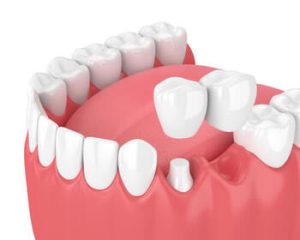A missing tooth may change how you chew, impact your speech, and shift nearby teeth out of place. A dental bridge is something to consider when exploring solutions for missing teeth. If you are wondering how a dental bridge works and whether it might suit your needs, learning about the process and types of bridges can help guide your decision. This comprehensive guide explores the essentials, including how bridges are made, their benefits, and how to care for them properly.
What Is a Dental Bridge?
By anchoring an artificial tooth to surrounding teeth or implants, a dental bridge fills the gap left by missing teeth and restores function. It is crafted with materials that aim to replicate the natural shade and appearance of your teeth.
Exploring the Types of Dental Bridges Available Today
Dental bridges come in several forms, each meeting unique dental requirements. Exploring these choices helps ensure the right fit for your smile.
Traditional Bridge: A Common Choice for Stability
In a traditional bridge, the teeth next to the gap are fitted with crowns that anchor the replacement tooth securely. This design provides strength and durability, making it suitable for replacing back teeth where chewing function is critical. Traditional dental bridges require the reduction of the two healthy teeth on either side to accommodate crowns. This option is often used when those teeth already need restoration or support. Because the bridge fills the space securely, it maintains alignment and bite stability.
 Cantilever Bridge: An Alternative When Only One Support Is Available
Cantilever Bridge: An Alternative When Only One Support Is Available
A cantilever dental bridge connects the artificial tooth to only one abutment tooth instead of two. This type of bridge is used when teeth are present on only one side of the gap created by tooth loss. While cantilever bridges can restore function in specific situations, they are not usually recommended for back teeth due to the forces involved in chewing. The design places more load on the supporting tooth, so careful evaluation by a dental practitioner is necessary. Cantilever bridges offer a solution when conventional bridges are not possible.
Maryland Bridge: A Minimal Preparation Option for Front Teeth
A Maryland bridge, also known as a resin bonded bridge, uses a metal or porcelain framework attached to the back of adjacent teeth with dental cement. This bridge type requires little to no removal of tooth structure, making it a conservative choice for replacing teeth in the front of the mouth. Maryland dental bridges are less intrusive but may have lower strength compared to traditional bridges. They are typically recommended for restoring front teeth where biting forces are reduced. Because the resin bonded design depends on bonding strength, good oral hygiene is essential for long-term success.
Implant Supported Bridge: Combining Stability with Modern Technology
Using dental implants for support, an implant supported bridge is a solution for patients lacking healthy teeth beside a span of missing teeth. Implants hold the bridge securely while preserving the health of remaining teeth. Implant supported bridges do not rely on prepared teeth, which helps maintain the integrity of other teeth in the mouth. The process involves placing implants first, then attaching the bridge once healing is complete. Implant supported bridges offer excellent stability and can restore chewing function effectively.
Provisional Bridge: A Temporary Solution During Treatment
A provisional bridge, or temporary bridge, is used while waiting for a permanent bridge to be made. This temporary solution protects prepared teeth and maintains appearance during the interim period. Although not designed for long-term use, a provisional bridge allows the patient to eat and speak comfortably until the final restoration is placed. The dental practitioner will customise the temporary bridge to fit well and blend with surrounding teeth. Patients wearing a provisional bridge should follow instructions carefully to avoid damaging the restoration before the permanent bridge is ready.
The Dental Bridge Procedure: Step by Step
Understanding how a dental bridge is placed can ease concerns and prepare you for each stage. The process involves several appointments to ensure a proper fit and lasting results.
Initial Consultation and Treatment Planning
The dental bridge procedure begins with a thorough consultation where the dental practitioner examines your teeth and discusses your needs. X rays and impressions may be taken to assess the condition of the supporting teeth and determine suitability for a bridge. The practitioner will explain the options available, including the types of dental bridges that may work effectively for your situation. This planning stage ensures the final restoration aligns with both functional and aesthetic goals. Once the treatment plan is confirmed, preparation for the bridge can begin.
Tooth Preparation for Bridge Placement
To prepare for a traditional bridge or similar restoration, the teeth on either side of the gap are reshaped to receive crowns. The dental practitioner will carefully remove a small amount of enamel from the prepared teeth to create room for the crowns that will hold the bridge. This step is vital to achieve a proper fit and stable support. After preparation, impressions are taken to guide the dental laboratory in fabricating the custom bridge. Temporary crowns or a bridge can help safeguard the prepared teeth, providing short-term coverage until the permanent restoration is placed.
Fabrication of the Custom Bridge at the Dental Laboratory
The impressions and specifications are forwarded to a dental lab where skilled technicians create the bridge. The bridge consists of one or more pontics attached to crowns or frameworks depending on the design. Materials such as porcelain fused to a metal substructure or all porcelain may be used based on the location of the bridge and aesthetic preferences. The dental laboratory focuses on matching the shape, size, and colour to the natural teeth. This stage may take several weeks to ensure a precise fit and appearance.
 Fitting and Adjusting the Bridge
Fitting and Adjusting the Bridge
Once the bridge is ready, it is checked in the mouth to evaluate fit, bite, and comfort. The dental practitioner will make necessary adjustments to ensure the bridge sits properly along the gum line and does not interfere with chewing or speech. Minor modifications help achieve an even bite and prevent pressure points on the supporting teeth. If the fit is satisfactory, the bridge may be temporarily cemented to allow for further assessment before final placement. The patient will be advised to monitor for any discomfort during this trial period.
Final Cementation and Completion of Treatment
After confirming the fit and function, the bridge is permanently secured using dental cement. The practitioner ensures the restoration is fully seated and that any excess cement is removed from around the gums. Instructions on caring for the new bridge will be provided to promote healing and maintain oral health. With proper placement, the bridge restores chewing function, prevents shifting of remaining teeth, and improves the appearance of the smile. Follow up visits may be scheduled to check the bridge and monitor supporting teeth.
The Many Benefits of Dental Bridges for Oral Health
A dental bridge offers more than cosmetic improvement. It plays a valuable role in maintaining oral health and function following tooth loss.
Restoring Chewing Function and Speech
Replacing teeth with a bridge helps restore the ability to chew food efficiently without discomfort. By filling the space, the bridge prevents difficulty in biting or speaking that may result from missing teeth. This improvement in function can enhance nutrition and overall well being. Proper chewing reduces strain on other teeth and supports digestive health. Speech clarity may also improve as tongue placement stabilises with restored teeth.
Preventing Shifting of Adjacent Teeth
A bridge prevents the remaining teeth from drifting into the gap created by tooth loss. Without replacement, adjacent teeth may tilt or shift, leading to misalignment and bite problems. Keeping teeth in their proper position preserves the dental arch and reduces the need for future orthodontic treatment. Preventing shifting helps maintain an even distribution of chewing forces across the bite. Preserving alignment also contributes to a balanced smile.
Preserving Facial Shape and Appearance
Missing teeth can affect facial fullness, resulting in a hollow appearance as the cheeks and lips lose necessary support. A bridge fills the space and helps maintain the natural contours of the face. This support can enhance confidence by restoring a fuller and more youthful appearance. Retaining facial structure may reduce premature wrinkling and collapse around the mouth. A dental bridge helps provide the structural integrity needed for facial balance.
Protecting Remaining Teeth from Excess Wear
Replacing missing teeth reduces excessive pressure on the other teeth that remain. A bridge distributes biting forces evenly, lowering the risk of overloading specific teeth. This protection can prevent accelerated wear or fractures in supporting teeth. Balanced force distribution promotes the long term health of the natural tooth structure. Preventing damage to remaining teeth supports longevity and overall oral health.
Offering a Fixed and Reliable Solution
Unlike removable partial dentures, a bridge is fixed in place and does not need to be taken out for cleaning. This stability provides convenience and peace of mind for daily activities. A fixed restoration feels more natural and secure when eating or speaking. Many patients appreciate the freedom of not worrying about removable appliances. A bridge offers a dependable solution that integrates seamlessly with the mouth.
Caring for Your Dental Bridge to Maintain Longevity
Proper care is essential to keep a dental bridge in good condition and protect supporting teeth from decay and gum disease.
Brushing Thoroughly with a Soft Toothbrush
Regular brushing with a soft bristled toothbrush helps clean around the bridge and prevent plaque buildup. Using gentle strokes protects the gum line and reduces irritation. Patients should brush twice daily using fluoride toothpaste to strengthen enamel and protect natural teeth. Paying attention to the bridge area reduces the risk of tooth decay beneath the crowns. Consistent brushing supports healthy gums and fresh breath.
Flossing with Special Tools Designed for Bridges
Cleaning under the false tooth requires floss threaders or interdental brushes that reach beneath the bridge. These tools help remove plaque and food debris that a toothbrush cannot reach. Daily cleaning under the bridge prevents bacteria from accumulating and causing gum problems. Flossing around the abutment teeth maintains the health of supporting teeth. The dental practitioner can recommend suitable cleaning aids for your specific bridge design.
 Attending Regular Dental Visits for Professional Checks
Attending Regular Dental Visits for Professional Checks
Routine dental checkups allow the dental practitioner to monitor the bridge and surrounding teeth for signs of wear or decay. A professional cleaning removes stubborn plaque and tartar, offering protection that home routines might overlook. Early diagnosis helps maintain the bridge’s function.
The practitioner may take periodic X-rays to evaluate the condition of supporting teeth and bone. Regular visits ensure proactive care and peace of mind.
Avoiding Hard Foods That Could Damage the Bridge
Patients wearing a dental bridge should steer clear of biting hard objects like ice or unpopped kernels to reduce the risk of breakage.
These items can place excessive force on the bridge or supporting teeth, risking cracks or dislodgement. Chewing sticky foods may also loosen the restoration over time. Choosing softer food options helps protect the integrity of the bridge. Watching your diet plays an important role in keeping the bridge in good condition for longer.
Maintaining Good Oral Hygiene Practices Daily
Excellent oral hygiene habits are key to keeping the bridge and natural teeth healthy. This includes brushing, flossing, using mouth rinses if recommended, and following personalised care instructions. A healthy mouth lessens the chance of gum disease and tooth decay that could compromise the bridge. Staying consistent with daily care protects your investment in oral health. A well-maintained bridge can last many years with proper attention.
Rediscover Confidence and Function with a Dental Bridge
Choosing a dental bridge can restore your smile, improve your bite, and protect the health of remaining teeth. By filling gaps with a well crafted bridge, you can enjoy renewed function and appearance. If you are considering this treatment, our team is ready to guide you through every step with personalised care. Call us today on (02) 6188 7103 to schedule your consultation and take the first step toward achieving your oral health goals.
References
https://www.colgate.com/en-in/oral-health/bridges-and-crowns/dental-bridges-and-oral-health
https://www.healthdirect.gov.au/dental-bridge


 Cantilever Bridge: An Alternative When Only One Support Is Available
Cantilever Bridge: An Alternative When Only One Support Is Available Fitting and Adjusting the Bridge
Fitting and Adjusting the Bridge Attending Regular Dental Visits for Professional Checks
Attending Regular Dental Visits for Professional Checks




